Building for Nature: Preserving Threatened Bird Habitat in Port Design
Abstract
1. Introduction
2. Methods for Sustainable Coastal Development
3. Study Area
3.1. The Jiangsu Coast and Tongzhou Bay
3.2. Ecotope Classification
3.3. Shorebird Distribution
4. Tongzhou Bay Morphodynamic Model
4.1. Setup
4.2. Validation
5. Ecotope Distribution
5.1. Initial Conditions
5.2. Alternative Port Configurations
6. Discussion
7. Conclusions
- 1.
- Full reclamation of the main shoal (as originally planned) will result in the loss of high-value ecotopes and the populations of birds utilizing them. Partial reclamation of the shoal will reduce the loss of valuable ecotopes, especially when accounting for morphological feedbacks. Partially reclaiming the south side of the shoal, for instance, leads to a reduction in currents and transport fluxes whereas partial reclamation of the north side strengthens siltation rates (which is positive for habitat suitability).
- 2.
- In order to increase the accuracy of the created ecotope map, it is recommended to increase the set of abiotic features and data sources for the ecotope classification and subsequent validation. More input of ecological and societal needs will increase the potential of the alternative design. Relevant and consistent measuring campaigns are important to achieve a better insight.
- 3.
- The BwN approach allows for multi-value design, where economic–social and natural needs can be included at an early stage. Multidisciplinary cooperation between different specialties will lead to a more successful end solution in terms of sustainability and societal support.
Author Contributions
Funding
Acknowledgments
Conflicts of Interest
References
- Davidson, N.C. How much wetland has the world lost? Long-term and recent trends in global wetland area. Mar. Freshw. Res. 2014, 65, 934–941. [Google Scholar] [CrossRef]
- Ma, Z.; Melville, D.S.; Liu, J.; Chen, Y.; Yang, H.; Ren, W.; Zhang, Z.; Piersma, T.; Li, B. Rethinking China’s new great wall. Science 2014, 346, 912–914. [Google Scholar] [CrossRef] [PubMed]
- Chen, Y.; Dong, J.; Xiao, X.; Ma, Z.; Tan, K.; Melville, D.; Li, B.; Lu, H.; Liu, J.; Liu, F. Effects of reclamation and natural changes on coastal wetlands bordering China’s Yellow Sea from 1984 to 2015. Land Degrad. Dev. 2019, 30, 1533–1544. [Google Scholar] [CrossRef]
- Salafsky, N.; Salzer, D.; Stattersfield, A.J.; Hilton-Taylor, C.; Neugarten, R.; Butchart, S.H.M.; Collen, B.; Cox, N.; Master, L.L.; O’Connor, S.; et al. A Standard Lexicon for Biodiversity Conservation: Unified Classifications of Threats and Actions. Conserv. Biol. 2008, 22, 897–911. [Google Scholar] [CrossRef] [PubMed]
- Piersma, T.; Chan, Y.-C.; Mu, T.; Hassell, C.J.; David, S.; Peng, H.-B.; Ma, Z.; Zhang, Z.; Wilcove, D.S. Loss of habitat leads to loss of birds: Reflections on the Jiangsu, China, coastal development plans. Wader Study 2017, 124, 93–98. [Google Scholar] [CrossRef]
- Piersma, T.; Lok, T.; Chen, Y.; Hassel, C.J.; Yang, H.Y.; Boyle, A.; Slaymaker, M.; Chan, Y.C.; Melville, D.S.; Zhang, Z.W.; et al. Simultaneous declines in summer survival of three shorebird species signals a flyway at risk. J. Appl. Ecol. 2016, 53, 479–490. [Google Scholar] [CrossRef]
- Studds, C.E.; Kendall, B.E.; Murray, N.J.; Wilson, H.B.; Rogers, D.I.; Clemens, R.S.; Milton, D.A. Rapid population decline in migratory shorebirds relying on Yellow Sea tidal mudflats as stopover sites. Nat. Commun. 2017, 8, 14895. [Google Scholar] [CrossRef]
- Barter, M.A. Shorebirds of the Yellow Sea: Importance, Threats and Conservation Status; Wetlands International: Canberra, Australia, 2002. [Google Scholar]
- MacKinnon, J.; Verkuil, Y.I.; Murray, N. IUCN Situation Analysis on East and Southeast Asian Intertidal Habitats, with Particular Reference to the Yellow Sea (Including the Bohai Sea), Occasional Paper of the IUCN Species Survival Commission No. 47; IUCN: Gland, Switzerland; Cambridge, UK, 2012. [Google Scholar]
- Bai, Q.; Chen, J.; Chen, Z.; Dong, G.; Dong, J.; Dong, W.; Wing, V.; Fu, K.; Han, Y.; Lu, G.; et al. Identification of coastal wetlands of international importance for waterbirds: A review of China Coastal Waterbird Surveys 2005–2013. Avian Res. 2015, 6, 12. [Google Scholar] [CrossRef]
- Battley, P.F.; Warnock, N.; Tibbitts, T.L.; Gill, R.E.; Piersma, T.; Hassell, C.J.; Douglas, D.C.; Mulcahy, D.M.; Gartell, B.D.; Schuckard, R.; et al. Contrasting extreme long-distance migration patterns in bar-tailed godwits Limosa lapponica. J. Avian Biol. 2012, 43, 21–32. [Google Scholar] [CrossRef]
- Liu, X.; Gao, S.; Wang, Y. Modeling profile shape evolution for accreting tidal flats composed of mud and sand: A case study of the central Jiangsu coast, China. Cont. Shelf Res. 2011, 31, 1750–1760. [Google Scholar] [CrossRef]
- Roberts, W.; Le Hir, P.; Whitehouse, R.J.S. Investigation using simple mathematical models of the effect of tidal currents and waves on the profile shape of intertidal mudflats. Cont. Shelf Res. 2000, 20, 1079–1097. [Google Scholar] [CrossRef]
- Li, X.; Zhang, L.; Ji, C.; Liu, H.; Huang, Q. Spatiotemporal changes of Jiangsu coastline: A remote sensing and GIS approach. Geogr. Res. 2014, 33, 414–426. [Google Scholar] [CrossRef]
- Song, D.; Wang, X.H.; Zhu, X.; Bao, X. Modeling studies of the far-field effects of tidal flat reclamation on tidal dynamics in the East China Seas. Estuar. Coast. Shelf Sci. 2013, 133, 147–160. [Google Scholar] [CrossRef]
- Zhu, Q.; Wang, Y.P.; Ni, W.; Gao, J.; Li, M.; Yang, L.; Gong, X.; Gao, S. Effects of intertidal reclamation on tides and potential environmental risks: A numerical study for the southern Yellow Sea. Environ. Earth Sci. 2016, 75. [Google Scholar] [CrossRef]
- Deng, B.; Wu, H.; Yang, S.; Zhang, J. Longshore suspended sediment transport and its implications for submarine erosion off the Yangtze River Estuary. Estuar. Coast. Shelf Sci. 2017, 190, 1–10. [Google Scholar] [CrossRef]
- Yang, H.-Y.; Chen, B.; Barter, M.A.; Piersma, T.; Zhou, C.-F.; Li, F.-S.; Zhang, Z.-W. Impacts of tidal land reclamation in Bohai Bay, China: Ongoing losses of critical Yellow Sea waterbird staging and wintering sites. Bird Conserv. Int. 2011, 21, 241–259. [Google Scholar] [CrossRef]
- de Vriend, H.J.; van Koningsveld, M.; Aarninkhof, S.G.J.; de Vries, M.B.; Baptist, M.J. Sustainable hydraulic engineering through building with nature. J. Hydro-Environ. Res. 2014, 9, 159–171. [Google Scholar] [CrossRef]
- Wang, F.; Wall, G. Mudflat development in Jiangsu Province, China: Practices and experiences. Ocean Coast. Manag. 2010, 53, 691–699. [Google Scholar] [CrossRef]
- Wang, W.; Liu, H.; Li, Y.; Su, J. Development and management of land reclamation in China. Ocean Coast. Manag. 2014, 102, 415–425. [Google Scholar] [CrossRef]
- Zhao, S.; Liu, Y.; Li, M.; Sun, C.; Zhou, M.; Zhang, H. Analysis of Jiangsu tidal flats reclamation from 1974 to 2012 using remote sensing. China Ocean Eng. 2015, 29, 143–154. [Google Scholar] [CrossRef]
- Zhang, C.K.; Chen, J. Master plan of tidal flat reclamation along Jiangsu coastal zone. In Proceedings of the 6th International Conference on Asian and Pacific Coasts, Hong Kong, China, 14–16 December 2011; pp. 139–146. [Google Scholar]
- Peng, H.-B.; Anderson, G.Q.A.; Chang, Q.; Choi, C.-Y.; Chowdhury, S.U.; Clark, N.A.; Gan, X.; Hearn, R.D.; Li, J.; Lappo, E.G.; et al. The intertidal wetlands of southern Jiangsu Province, China—Globally important for Spoon-billed Sandpipers and other threatened waterbirds, but facing multiple serious threats. Bird Conserv. Int. 2017, 27, 305–322. [Google Scholar] [CrossRef]
- Mu, T.; Wilcove, D.S. Upper tidal flats are disproportionately important for the conservation of migratory shorebirds. Proc. R. Soc. B 2020, 287. [Google Scholar] [CrossRef] [PubMed]
- Huang, L.; Zhang, W. Layout scheme of the first and second harbor basin in Tongzhou Bay Port. China Harb. Eng. 2017, 37, 39–43. [Google Scholar] [CrossRef]
- Liang, S.; Pearson, S.; Wu, W.; Ma, Y.; Qiao, L.; Wang, X.H.; Li, J.; Wang, X. Research and integrated coastal zone management in rapidly developing estuarine harbours: A review to inform sustainment of functions in Jiaozhou Bay, China. Ocean Coast. Manag. 2015, 116, 470–477. [Google Scholar] [CrossRef]
- Muller, J.R.M.; Chen, Y.; Aarninkhof, S.G.J.; Chan, Y.-C.; Piersma, T.; van Maren, D.S.; Tao, J.; Wang, Z.B.; Gong, Z. Ecological impact of land reclamation on Jiangsu coast (China): A novel ecotope assessment for Tongzhou Bay. Water Sci. Eng. 2020, 13, 57–64. [Google Scholar] [CrossRef]
- van de Kam, J.; Battley, P.F.; McCaffery, B.J.; Rogers, D.I.; Hong, J.S.; Moores, N.; Yu, Y.-K.; Lewis, J.; Piersma, T. Invisible Connections: Why Migrating Shorebirds Need the Yellow Sea; CSIRO Publishing: Melbourne, Austria, 2010. [Google Scholar]
- van de Kam, J.; Ens, B.J.; Piersma, T.; Zwarts, L. Shorebirds: An Illustrated Behavioural Ecology; KNNV Publishers: Utrecht, The Netherlands, 2004. [Google Scholar]
- Mathot, K.J.; Piersma, T.; Elner, R.W. Shorebirds as Indicators and Integrators of Mudflat Ecology; Beninger, P., Ed.; Springer: Cham, Switzerland, 2018; pp. 309–338. [Google Scholar]
- Chan, Y.-C.; Tibbitts, T.L.; Lok, T.; Hassell, C.J.; Peng, H.-B.; Ma, Z.; Zhang, Z.; Piersma, T. Filling knowledge gaps in a threatened shorebird flyway through satellite tracking. J. Appl. Ecol. 2019, 56, 2305–2315. [Google Scholar] [CrossRef]
- Zhang, S.-D.; Ma, Z.; Choi, C.-Y.; Peng, H.-B.; Melville, D.S.; Zhao, T.-T.; Bai, Q.-Q.; Liu, W.-L.; Chan, Y.-C.; van Gils, J.A.; et al. Morphological and digestive adjustments buffer performance: How staging shorebirds cope with severe food declines. Ecol. Evol. 2019, 9, 3868–3878. [Google Scholar] [CrossRef]
- Choi, C.-Y.; Battley, P.F.; Potter, M.A.; Ma, Z.; Melville, D.S.; Sukkaewmanee, P. How migratory shorebirds selectively exploit prey at a staging site dominated by a single prey species. Auk 2017, 134, 76–91. [Google Scholar] [CrossRef]
- Duijns, S.; Hidayati, N.A.; Piersma, T. Bar-tailed Godwits Limosa l. lapponica eat polychaete worms wherever they winter in Europe. Bird Study 2013, 60, 509–517. [Google Scholar] [CrossRef][Green Version]
- Duijns, S.; Piersma, T. Interference competition in a sexually dimorphic shorebird: Prey behaviour explains intraspecific competition. Anim. Behav. 2014, 92, 195–201. [Google Scholar] [CrossRef]
- Rakhimberdiev, E.; Duijns, S.; Karagicheva, J.; Camphuysen, C.J.; Castricum, V.R.S.; Dekinga, A.; Dekker, R.; Gavrilov, A.; ten Horn, J.; Jukema, J.; et al. Food abundance at refuelling sites can mitigate Arctic warming effects on a migratory bird. Nat. Commun. 2018, 9. [Google Scholar] [CrossRef]
- van Maren, D.S.; Oost, A.P.; Wang, Z.B.; Vos, P.C. The effect of land reclamations and sediment extraction on the suspended sediment concentration in the Ems Estuary. Mar. Geol. 2016, 376, 147–157. [Google Scholar] [CrossRef]
- Wang, Z.B.; van Maren, D.S.; Ding, P.X.; Yang, S.L.; van Prooijen, B.C.; de Vet, P.L.M.; Winterwerp, J.C.; de Vriend, H.J.; Stive, M.J.F.; He, Q. Human impacts on morphodynamic thresholds in estuarine systems. Cont. Shelf Res. 2015, 111, 174–183. [Google Scholar] [CrossRef]
- Winterwerp, J.C.; Wang, Z.B.; van Braeckel, A.; van Holland, G.; Kösters, F. Man-induced regime shifts in small estuaries—II: A comparison of rivers. Ocean Dyn. 2013, 63, 1293–1306. [Google Scholar] [CrossRef]
- IADC. Facts about Building with Nature; IADC: Voorburg, The Netherlands, 2010. [Google Scholar]
- Mink, F.J. Maritime Infrastructure and Marine Coastal Zones—Issues with the Habitats Directives, European Dredging Association Paper 06-0347; European Dredging Association: Brussels, Belgium, 2007. [Google Scholar]
- Baptist, M.J.; van Eekelen, E.; Dankers, P.J.T.; Grasmeijer, B.; van Kessel, T.; van Maren, D.S. Working with Nature in Wadden Sea ports. In Proceedings of the Coasts & Ports 2017 Conference, Cairns, Australia, 21–23 June 2017. [Google Scholar]
- Port of Rotterdam Authority. Maasvlakte 2—The sustainable Port; Port of Rotterdam Authority: Rotterdam, The Netherlands, 2008. [Google Scholar]
- Fordeyn, J.; Van der Biest, K.; Lemey, E.; Boerema, A.; Meire, P. An ecosystem services assessment of the Prins Hendrik Zanddijk. Terra Aqua 2019, 157, 31–46. [Google Scholar]
- Laboyrie, H.P.; van Koningsveld, M.; Aarninkhof, S.G.J.; Van Parys, M.; Lee, M.; Jensen, M.; Csiti, A.; Kolman, R. Dredging for Sustainable Infrastructure; CEDA/IADC: The Hague, The Netherlands, 2018. [Google Scholar]
- de Vriend, H.J.; van Koningsveld, M. Building with Nature: Thinking, Acting and Interacting Differently; EcoShape, Building with Nature: Dordrecht, The Netherlands, 2012. [Google Scholar]
- Cui, B. Impact of Large-scale Reclamation on Coastal Wetlands and Implications for Ecological Restoration, Compensation, and Sustainable Exploitation Framework. Bull. Chin. Acad. Sci. 2017, 32, 418–425. [Google Scholar] [CrossRef]
- CCCC Third Harbor Consultants Co. Ltd. Hydrological Analysis Report of Tongzhou Qianwan Planning; CCCC Third Harbor Consultants Co. Ltd.: Shanghai, China, 2012. [Google Scholar]
- Liu, Z.; Huang, Y.; Zhang, Q. Tidal current ridges in the southwestern Yellow Sea. J. Sediment. Res. 1989, 59, 432437. [Google Scholar]
- Wang, Y.; Zhu, D.; You, K.; Pan, S.; Zhu, X.; Zou, X. Evolution of radiative sand ridge field of the South Yellow Sea and its sedimentary characteristics. Sci. China Ser. D: Earth Sci. 1999, 42, 97–112. [Google Scholar] [CrossRef]
- Yan, Y.; Zhu, Y.; Xue, H. Hydromechanics for the formation and development of radial sandbanks—Plane characteristics of tidal flow. Sci. China Ser. D: Earth Sci. 1999, 42, 13–21. [Google Scholar] [CrossRef]
- Zhang, C.; Zhang, D.; Zhang, J.; Wang, Z. Tidal current-induced formation—Storm-induced change—Tidal current-induced recovery. Sci. China Ser. D Earth Sci. 1999, 42, 1–12. [Google Scholar] [CrossRef]
- Kang, Y. Maximum tidal range analysis of radial sand ridges in the southern Yellow Sea. Indian J. Geo-Mar. Sci. 2015, 44, 971–976. [Google Scholar]
- Xing, F.; Wang, Y.P.; Wang, H.V. Tidal hydrodynamics and fine-grained sediment transport on the radial sand ridge system in the southern Yellow Sea. Mar. Geol. 2012, 291, 192–210. [Google Scholar] [CrossRef]
- Su, M.; Yao, P.; Wang, Z.B.; Zhang, C.K.; Stive, M.J.F. Tidal Wave Propagation in the Yellow Sea. Coast. Eng. J. 2015, 57, 1550008. [Google Scholar] [CrossRef]
- Yao, P. Tidal and Sediment Dynamics in a Fine-Grained Coastal Region: A Case Study of the Jiangsu Coast. Ph.D. Thseis, Delft University of Technology, Delft, The Netherlands, 2016. [Google Scholar]
- Chen, K. Study on Characteristics of Flow and Sediment for Xiaomiaohong Tide Inlet in Radial Sand Ridges. Appl. Mech. Mater. 2013, 405–408, 1385–1389. [Google Scholar] [CrossRef]
- Wang, Y.P.; Gao, S.; Jia, J.; Thompson, C.E.L.; Gao, J.; Yang, Y. Sediment transport over an accretional intertidal flat with influences of reclamation, Jiangsu coast, China. Mar. Geol. 2012, 291–294, 147–161. [Google Scholar] [CrossRef]
- Xiong, J.; Wang, X.H.; Wang, Y.P.; Chen, J.; Shi, B.; Gao, J.; Yang, Y.; Yu, Q.; Li, M.; Yang, L.; et al. Reprint of Mechanisms of maintaining high suspended sediment concentration over tide-dominated offshore shoals in the southern Yellow Sea. Estuar. Coast. Shelf Sci. 2017, 191, 221–233. [Google Scholar] [CrossRef]
- Yang, B.; Feng, W.; Zhang, Y. Wave characteristics at the south part of the radial sand ridges of the Southern Yellow Sea. China Ocean Eng. 2014, 28, 317–330. [Google Scholar] [CrossRef]
- Chen, Y.; Xie, D.; Zhang, C.; Qian, X. Estimation of long-term wave statistics in the East China Sea. J. Coast. Res. 2013, 65, 177–182. [Google Scholar] [CrossRef]
- Wang, X.H.; Qiao, F.; Lu, J.; Gong, F. The turbidity maxima of the northern Jiangsu shoal-water in the Yellow Sea, China. Estuar. Coast. Shelf Sci. 2011, 93, 202–211. [Google Scholar] [CrossRef]
- Su, M.; Yao, P.; Wang, Z.B.; Zhang, C.K.; Stive, M.J.F. Exploratory morphodynamic hindcast of the evolution of the abandoned Yellow River delta, 1578–1855CE. Mar. Geol. 2017, 383, 99–119. [Google Scholar] [CrossRef]
- Wang, Y.; Zhang, Y.; Zou, X.; Zhu, D.; Piper, D. The sand ridge field of the South Yellow Sea: Origin by river–sea interaction. Mar. Geol. 2012, 291–294, 132–146. [Google Scholar] [CrossRef]
- Zhu, Y.; Chang, R. On the relationships between the radial tidal current field and the radial sand ridges in the southern Yellow Sea: A numerical simulation. Geo-Mar. Lett. 2001, 21, 59–65. [Google Scholar] [CrossRef]
- Zhu, Y.; Chen, Q. On the origin of the Radial Sand Ridges in the Southern Yellow Sea: Results from the modeling of the paleoradial tidal current fields off the Paleo-Yangtze River Estuary and Northern Jiangsu Coast. J. Coast. Res. 2005, 216, 1245–1256. [Google Scholar] [CrossRef]
- Su, M.; Yao, P.; Wang, Z.B.; Zhang, C.K.; Stive, M.J.F. Exploratory morphodynamic modeling of the evolution of the Jiangsu coast, China, since 1855: Contributions of old Yellow River-derived sediment. Mar. Geol. 2017, 390, 306–320. [Google Scholar] [CrossRef]
- Zhou, L.; Liu, J.; Saito, Y.; Zhang, Z.; Chu, H.; Hu, G. Coastal erosion as a major sediment supplier to continental shelves: Example from the abandoned Old Huanghe (Yellow River) delta. Cont. Shelf Res. 2014, 82, 43–59. [Google Scholar] [CrossRef]
- Gao, M.; Xu, L.; Li, G. The study of scoring and silting evolution of radiative sand ridge field of the south Yellow Sea in support of DEM. Mar. Sci. Bull. 2009, 28, 168–176. [Google Scholar]
- Li, C.; Zhang, J.; Deng, B. Holocene regression and the tidal radial sand ridge system formation in the Jiangsu coastal zone, east China. Mar. Geol. 2001, 173, 97–120. [Google Scholar] [CrossRef]
- Fan, D. Open-Coast Tidal Flats. In Principles of Tidal Sedimentology; Davis, R.A., Dalrymple, R.W., Eds.; Springer: Dordrecht, The Netherlands, 2012; pp. 187–229. [Google Scholar]
- Sun, Z.; Wang, F.; Yin, Y.; Li, G.; Ge, S.; Xu, Q. Sedimentary environment evolution of Lanshayang tidal channel within the radial sand ridges, Southern Yellow Sea. J. Nanjing Univ. Nat. Sci. 2014, 50, 553–563. [Google Scholar] [CrossRef]
- Wang, X.; Ke, X. Grain-size characteristics of the extant tidal flat sediments along the Jiangsu coast, China. Sediment. Geol. 1997, 112, 105–122. [Google Scholar] [CrossRef]
- Zhu, Y.; Chang, R. Preliminary study of the dynamic origin of the distribution pattern of bottom sediments on the continental shelves of the Bohai Sea, Yellow Sea and East China Sea. Estuar. Coast. Shelf Sci. 2000, 51, 663–680. [Google Scholar] [CrossRef]
- Lee, H.J.; Chough, S.K. Sediment distribution, dispersal and budget in the Yellow Sea. Mar. Geol. 1989, 87, 195–205. [Google Scholar] [CrossRef]
- Liu, J.P.; Xu, K.H.; Li, A.C.; Milliman, J.D.; Velozzi, D.M.; Xiao, S.B.; Yang, Z.S. Flux and fate of Yangtze River sediment delivered to the East China Sea. Geomorphology 2007, 85, 208–224. [Google Scholar] [CrossRef]
- Bouma, H.; de Jong, D.J.; Twisk, F.; Wolfstein, K. Zoute wateren EcotopenStelsel (ZES.1). Voor Het in Kaart Brengen van het Potentiële Voorkomen van Levensgemeenschappen in Zoute en Brakke Rijkswateren; Ministerie van Verkeer en Waterstaat: Middelburg, The Netherlands, 2005. [Google Scholar]
- Baptist, M.J.; van der Wal, J.T.; Folmer, E.O.; Gräwe, U.; Elschot, K. An ecotope map of the trilateral Wadden Sea. J. Sea Res. 2019, 152, 101761. [Google Scholar] [CrossRef]
- Chan, Y.-C.; Peng, H.-B.; Han, Y.X.; Chung, S.S.W.; Li, J.; Zhang, L.; Piersma, T. Conserving unprotected important coastal habitats in the Yellow Sea: Shorebird occurrence, distribution and food resources at Lianyungang. Glob. Ecol. Conserv. 2019, 20, e00724. [Google Scholar] [CrossRef]
- Douglas, D.C.; Weinzierl, R.; Davidson, S.C.; Kays, R.; Wikelski, M.; Bohrer, G. Moderating Argos location errors in animal tracking data. Methods Ecol. Evol. 2012, 3, 999–1007. [Google Scholar] [CrossRef]
- QGIS Development Team. QGIS Geographic Information System; Open Source Geospatial Foundation: Beaverton, OR, USA, 2009. [Google Scholar]
- Lesser, G.R.; Roelvink, J.A.; van Kester, J.A.T.M.; Stelling, G.S. Development and validation of a three-dimensional morphological model. Coast. Eng. 2004, 51, 883–915. [Google Scholar] [CrossRef]
- Yao, P.; Su, M.; Wang, Z.; van Rijn, L.C.; Zhang, C.; Chen, Y.; Stive, M.J.F. Experiment inspired numerical modeling of sediment concentration over sand-silt mixtures. Coast. Eng. 2015, 105, 75–89. [Google Scholar] [CrossRef]
- van Rijn, L.C. Unified View of Sediment Transport by Currents and Waves. I: Initiation of Motion, Bed Roughness, and Bed-Load Transport. J. Hydraul. Eng. 2007, 133, 649–667. [Google Scholar] [CrossRef]
- van Rijn, L.C. Unified View of Sediment Transport by Currents and Waves. II: Suspended Transport. J. Hydraul. Eng. 2007, 133, 668–689. [Google Scholar] [CrossRef]
- Partheniades, E. Erosion and Deposition of Cohesive Soils. J. Hydraul. Div. 1965, 91, 105–139. [Google Scholar]
- Ranasinghe, R.; Swinkels, C.; Luijendijk, A.; Roelvink, D.; Bosboom, J.; Stive, M.; Walstra, D. Morphodynamic upscaling with the MORFAC approach: Dependencies and sensitivities. Coast. Eng. 2011, 58, 806–811. [Google Scholar] [CrossRef]
- Nash, J.E.; Sutcliffe, J.V. River flow forecasting through conceptual models part I—A discussion of principles. J. Hydrol. 1970, 10, 282–290. [Google Scholar] [CrossRef]
- van Rijn, L.C.; Walstra, D.J.R.; Grasmeijer, B.; Sutherland, J.; Pan, S.; Sierra, J.P. The predictability of cross-shore bed evolution of sandy beaches at the time scale of storms and seasons using process-based Profile models. Coast. Eng. 2003, 47, 295–327. [Google Scholar] [CrossRef]
- Allen, J.I.; Somerfield, P.J.; Gilbert, F.J. Quantifying uncertainty in high-resolution coupled hydrodynamic-ecosystem models. J. Mar. Syst. 2007, 64, 3–14. [Google Scholar] [CrossRef]
- Henriksen, H.J.; Troldborg, L.; Nyegaard, P.; Sonnenborg, T.O.; Refsgaard, J.C.; Madsen, B. Methodology for construction, calibration and validation of a national hydrological model for Denmark. J. Hydrol. 2003, 280, 52–71. [Google Scholar] [CrossRef]
- Gong, Z.; Wang, Z.; Stive, M.J.F.; Zhang, C.; Chu, A. Process-Based Morphodynamic Modeling of a Schematized Mudflat Dominated by a Long-Shore Tidal Current at the Central Jiangsu Coast, China. J. Coast. Res. 2012, 285, 1381–1392. [Google Scholar] [CrossRef]
- Wu, J.; Xu, M.; Liu, B. Study on tidal flat evolution trend in the Yao sandbank area based on remote sensing. Coast. Eng. J. 2016, 35, 19–31. [Google Scholar] [CrossRef]
- Chen, K.; Zheng, J.; Zhang, C.; Wang, N.; Zhou, C. The evolution characteristics of main waterways and their control mechanism in the radial sand ridges of the southern Yellow Sea. Acta Oceanol. Sin. 2017, 36, 91–98. [Google Scholar] [CrossRef]
- Ding, X.R.; Kang, Y.Y.; Ge, X.P.; Li, Q.; Zhang, T.T. Tidal flat evolution analysis using remote sensing on Tiaozini flat of the radial sand ridges. J. Hohai Univ. Nat. Sci. 2011, 39, 231–236. [Google Scholar] [CrossRef]
- Yang, H.-Y.; Chen, B.; Ma, Z.; Hua, N.; Van Gils, J.A.; Zhang, Z.-W.; Piersma, T. Economic design in a long-distance migrating molluscivore: How fast-fuelling red knots in Bohai Bay, China, get away with small gizzards. J. Exp. Biol. 2013, 216, 3627–3636. [Google Scholar] [CrossRef]
- Zhang, S.-D.; Ma, Z.; Choi, C.-Y.; Peng, H.-B.; Bai, Q.-Q.; Liu, W.-L.; Tan, K.; Melville, D.S.; He, P.; Chan, Y.-C.; et al. Persistent use of a shorebird staging site in the Yellow Sea despite severe declines in food resources implies a lack of alternatives. Bird Conserv. Int. 2018, 28, 534–548. [Google Scholar] [CrossRef]
- Rogers, D.I.; Piersma, T.; Hassell, C.J. Roost availability may constrain shorebird distribution: Exploring the energetic costs of roosting and disturbance around a tropical bay. Biol. Conserv. 2006, 133, 225–235. [Google Scholar] [CrossRef]
- Mao, Y.; Lin, F.; Fang, J.; Fang, J.; Li, J.; Du, M. Bivalve Production in China. In Goods and Services of Marine Bivalves; Smaal, A.C., Ferreira, J.G., Grant, J., Petersen, J.K., Strand, Ø., Eds.; Springer International Publishing: Cham, Switzerland, 2019; pp. 51–72. ISBN 978-3-319-96776-9.101. [Google Scholar]
- Elith, J.; Leathwick, J.R. Species distribution models: Ecological explanation and prediction across space and time. Annu. Rev. Ecol. Evol. Syst. 2009, 40, 677–697. [Google Scholar] [CrossRef]
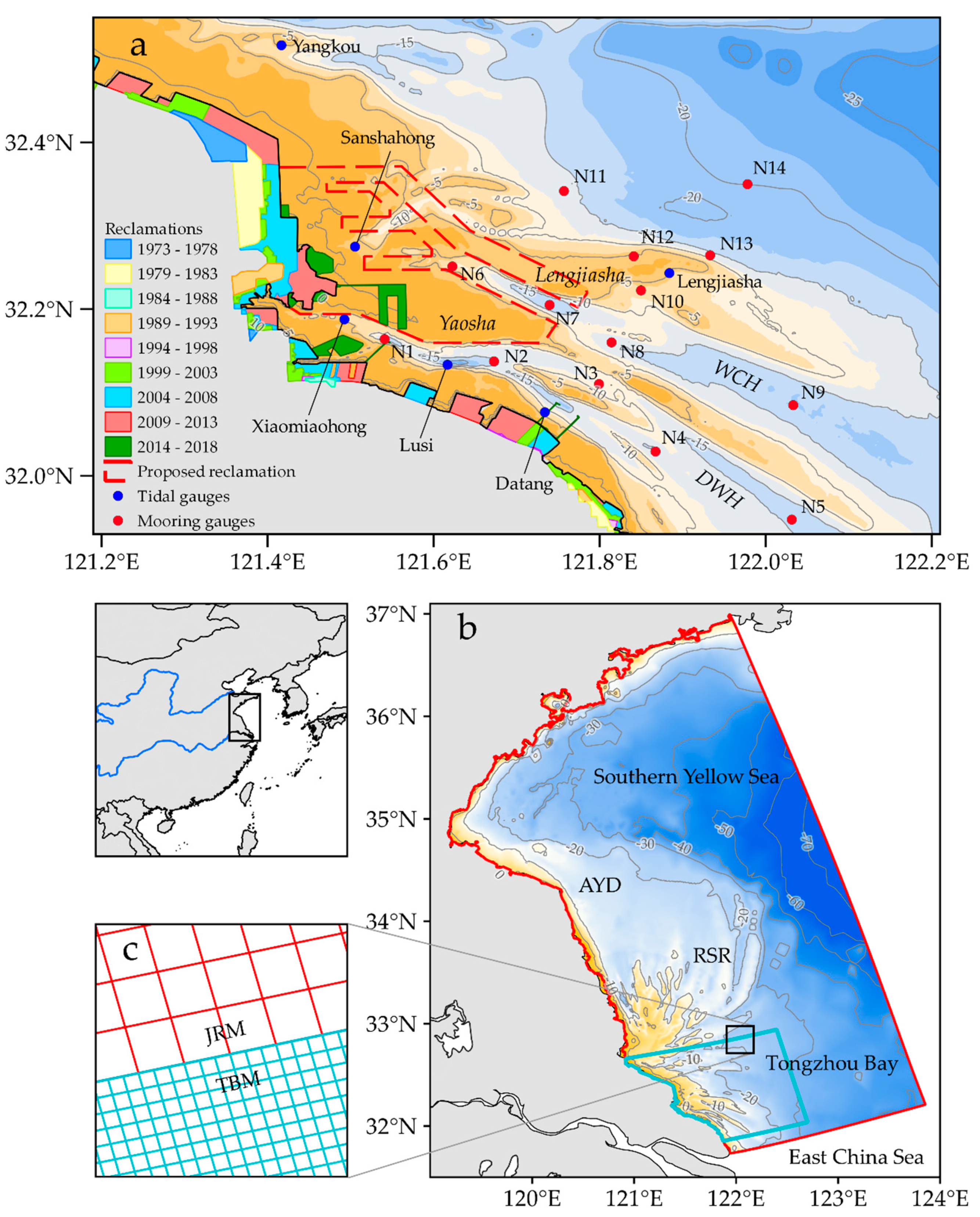
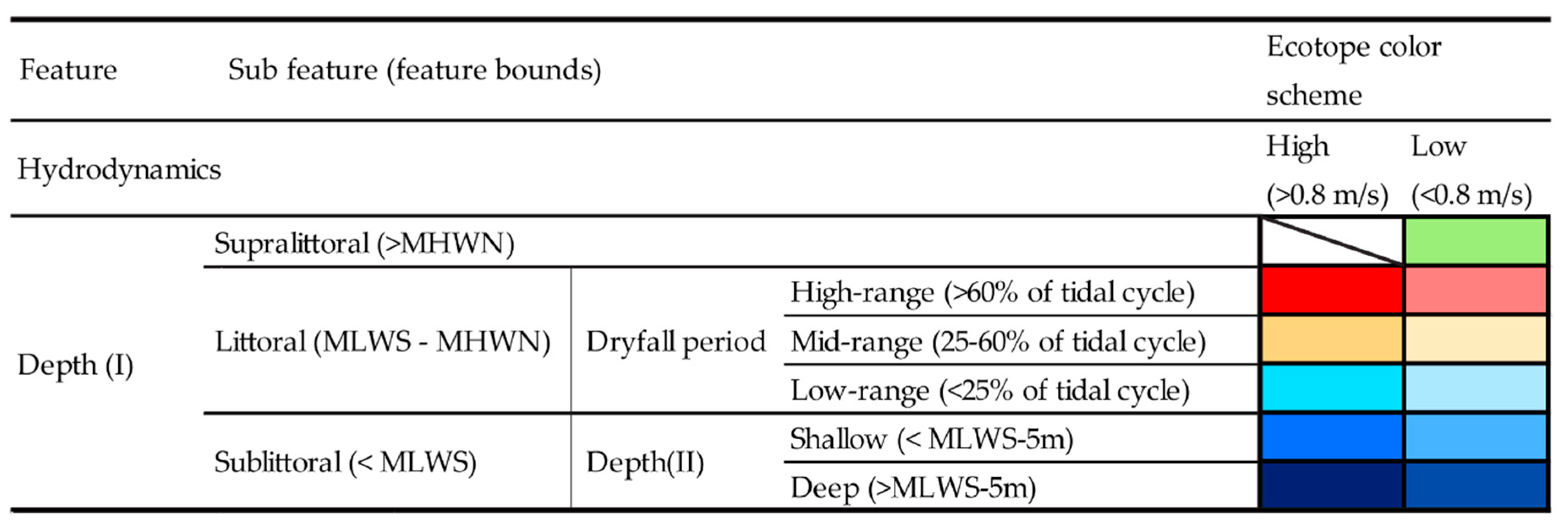
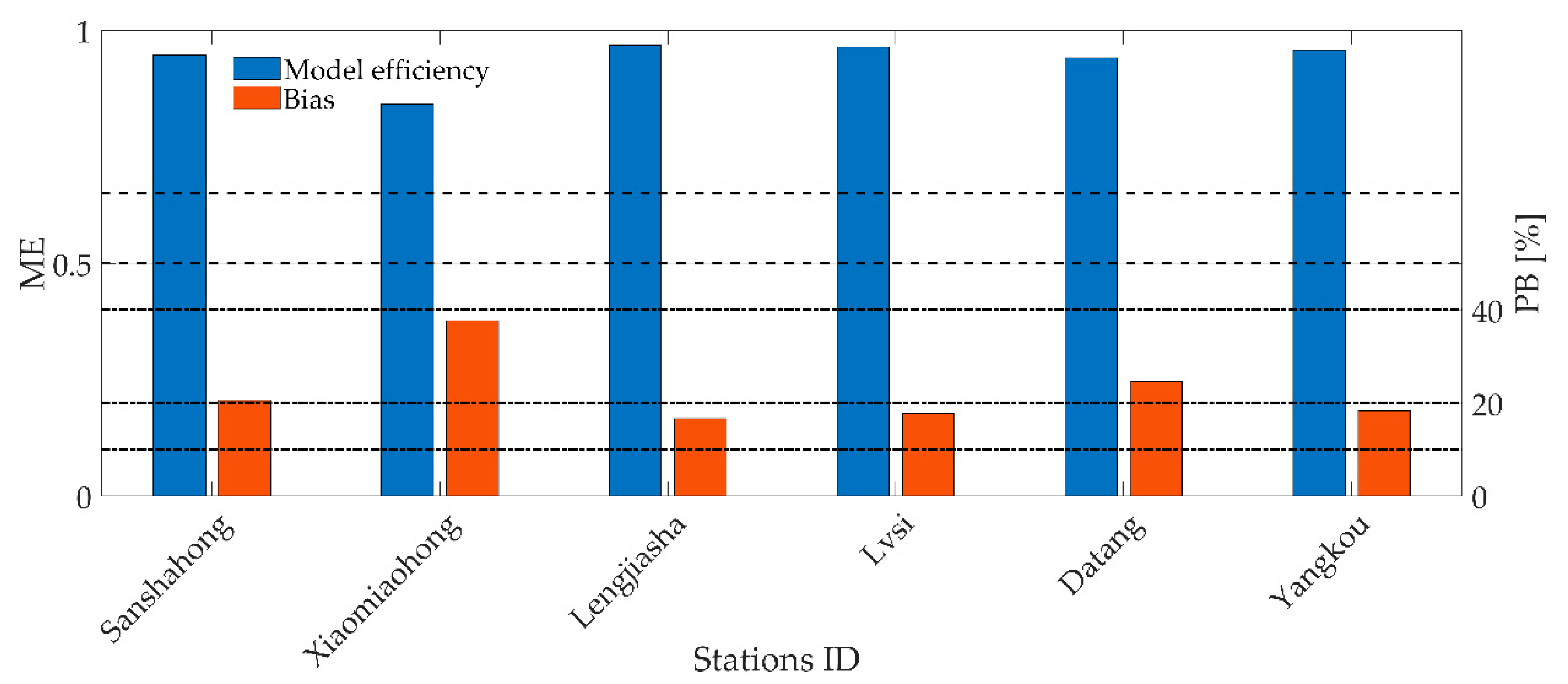

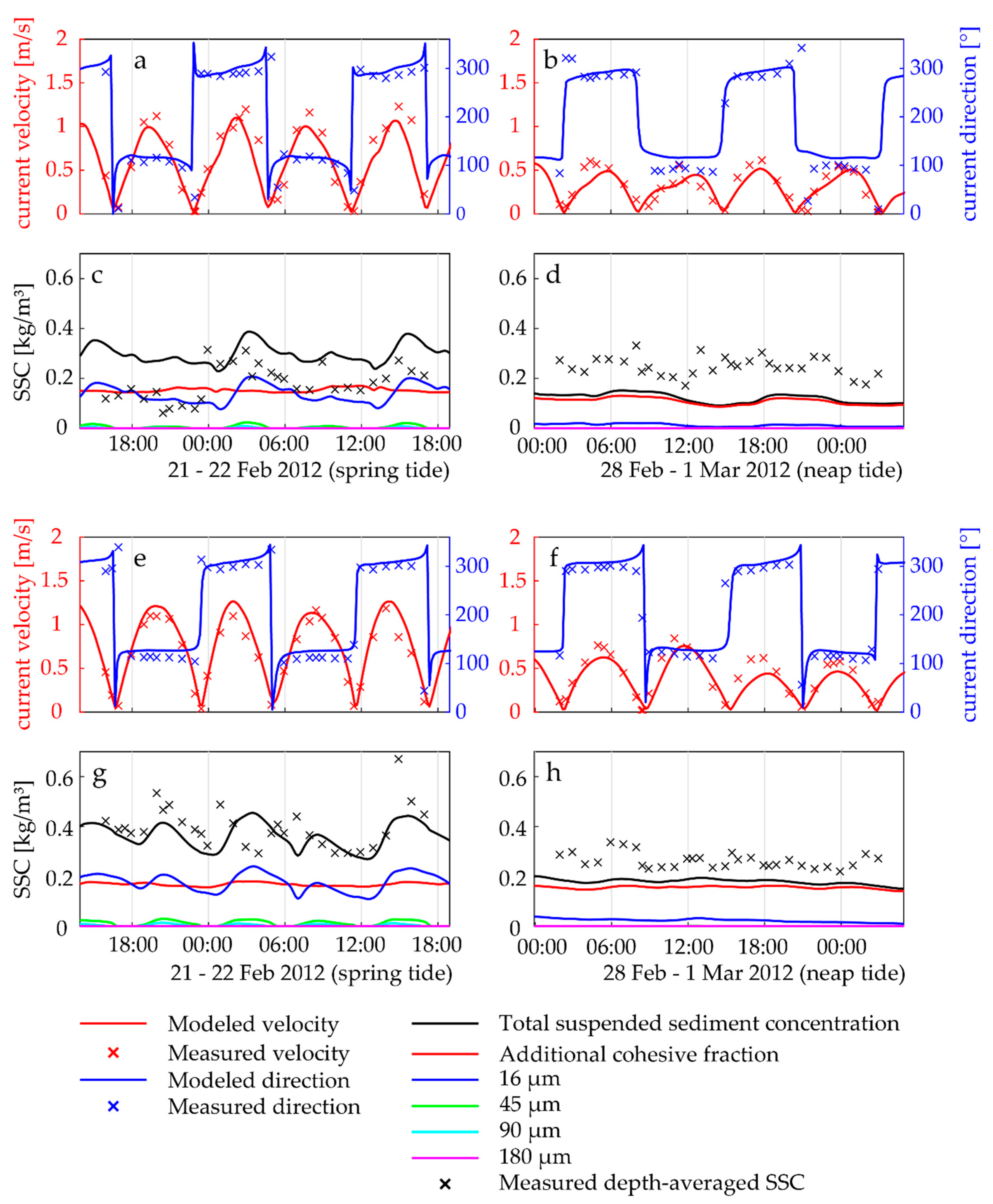
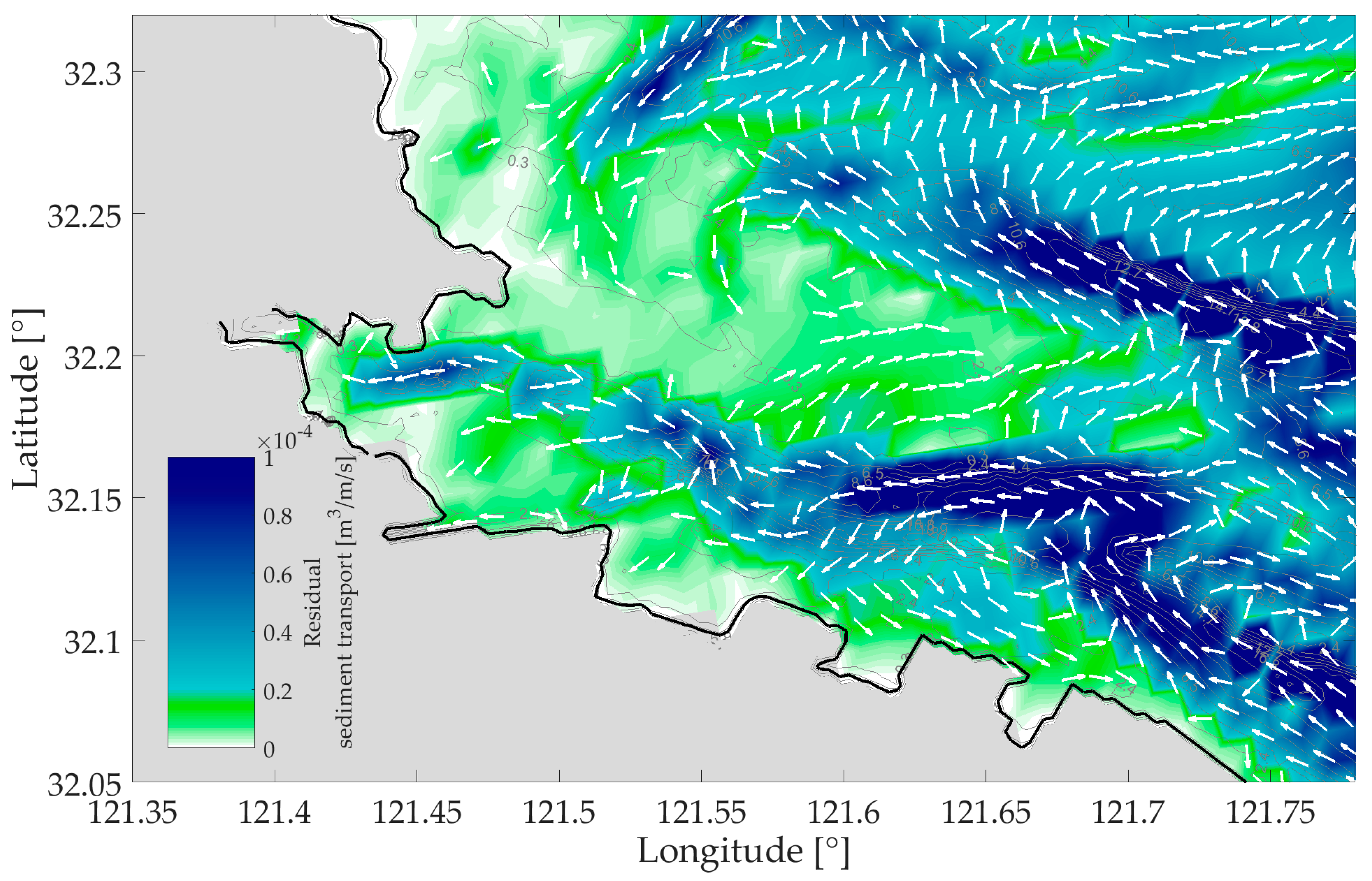
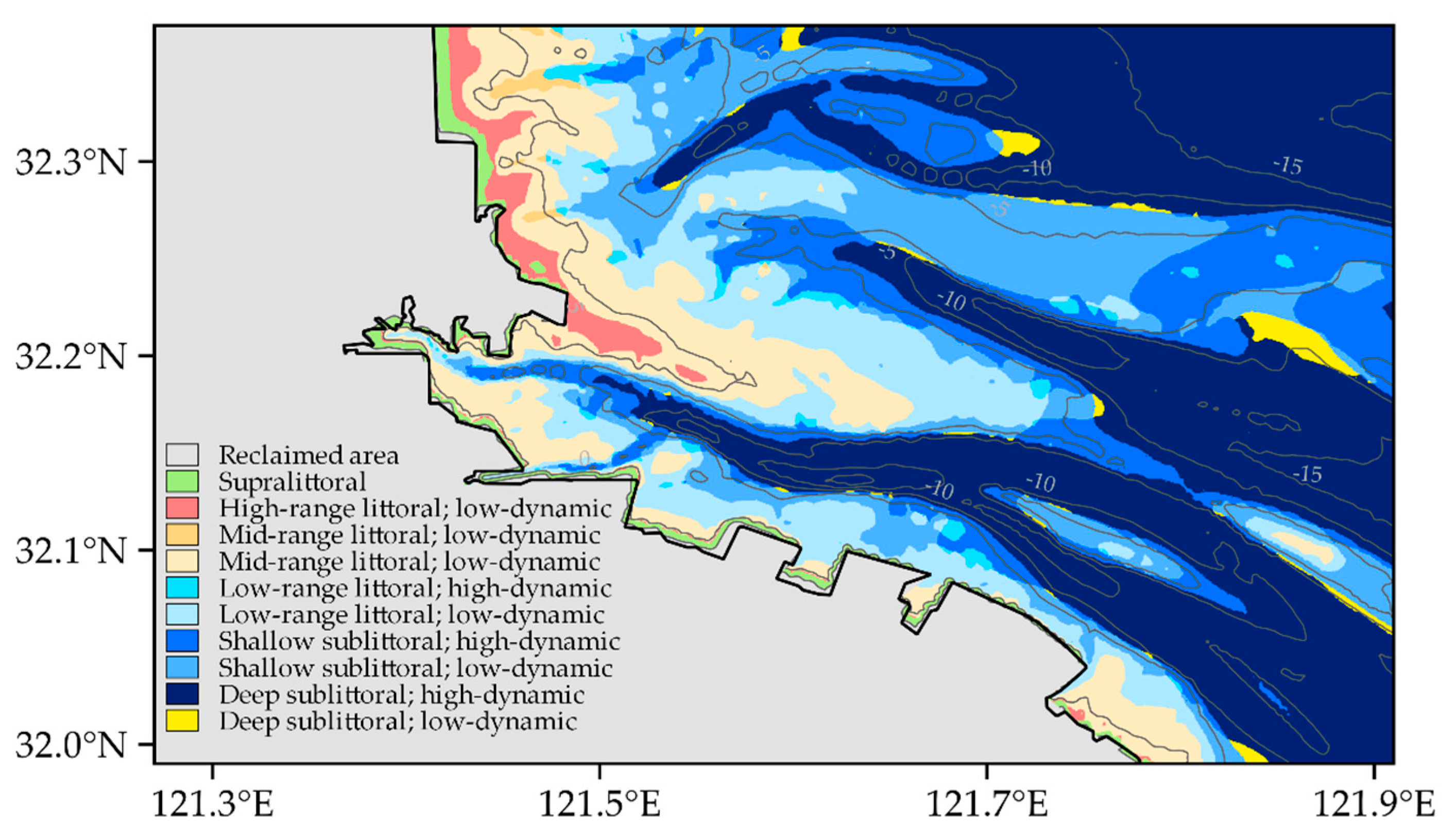
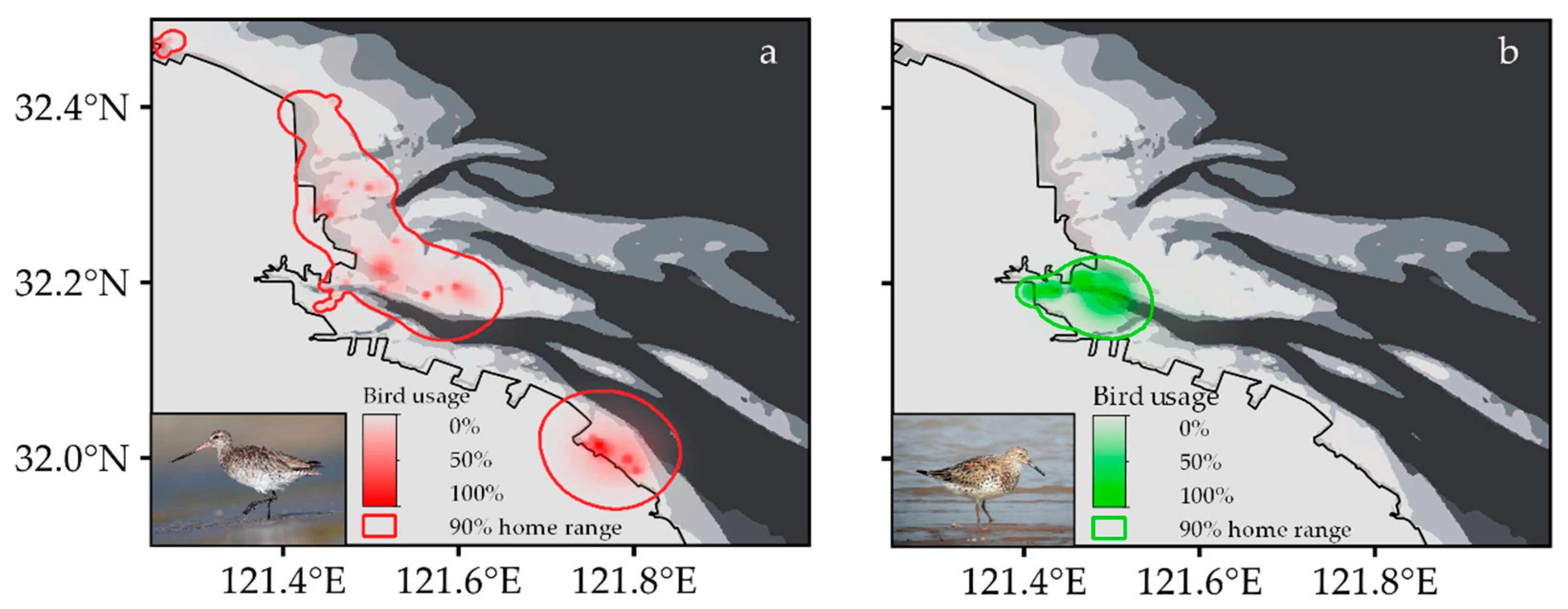
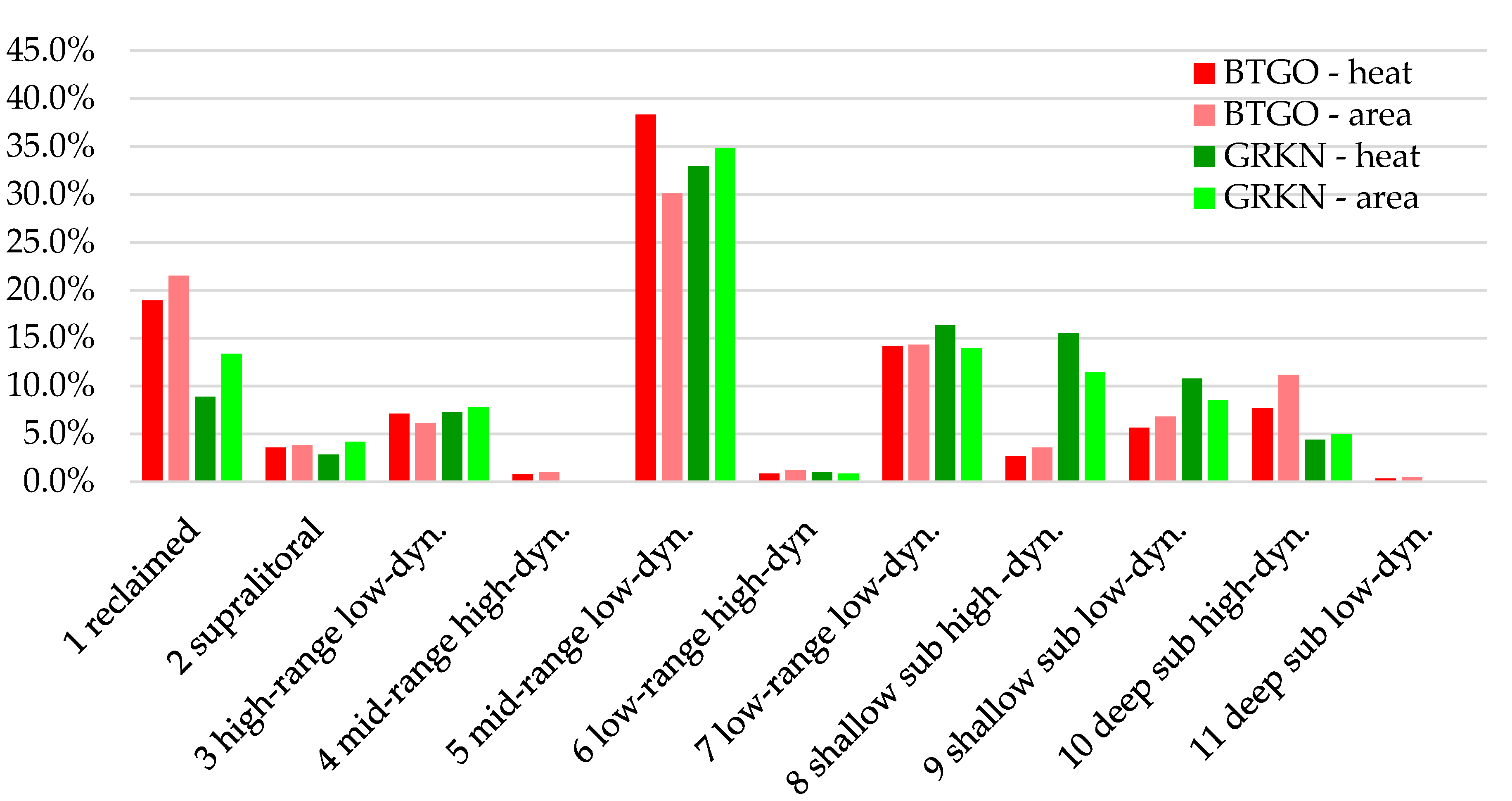
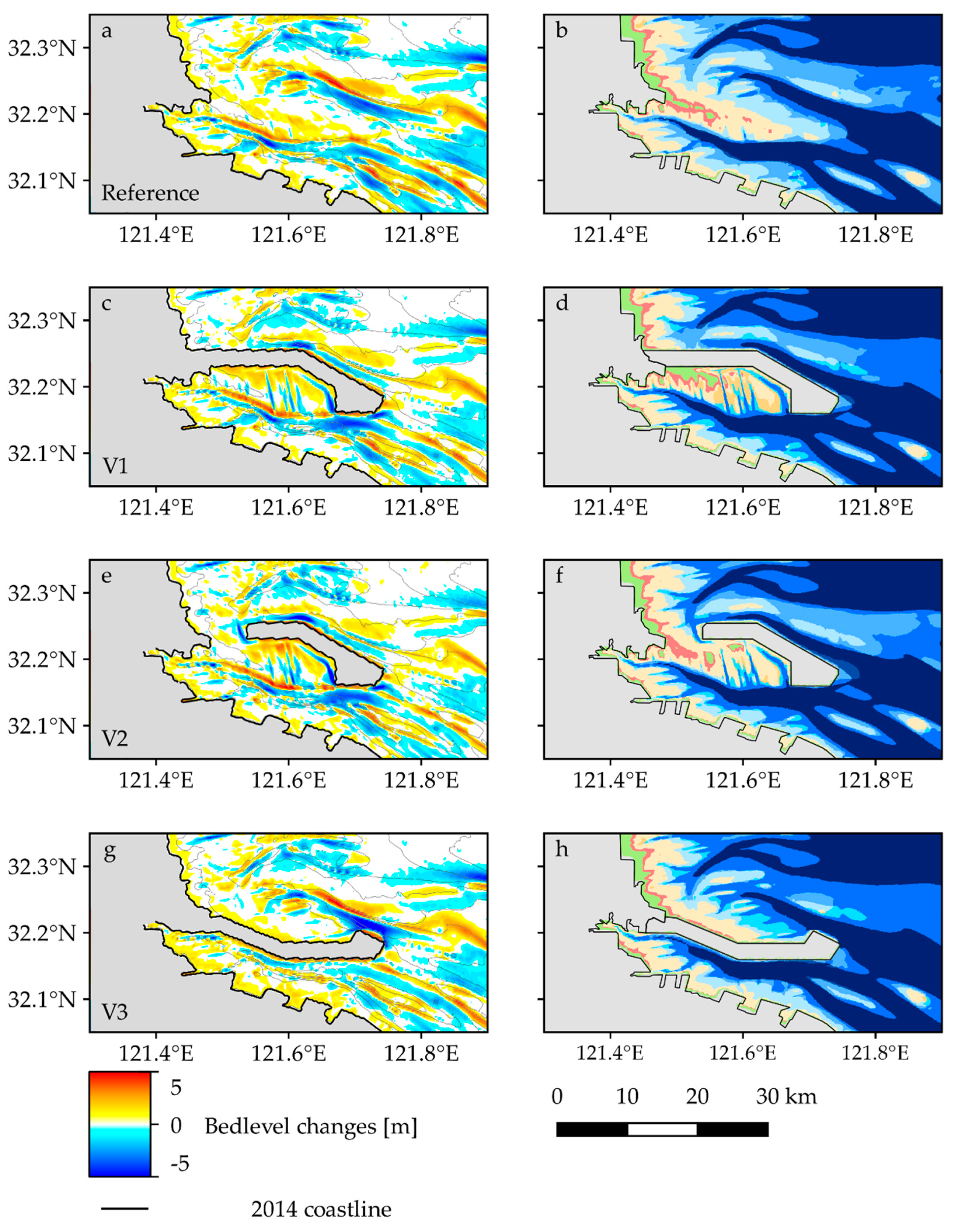
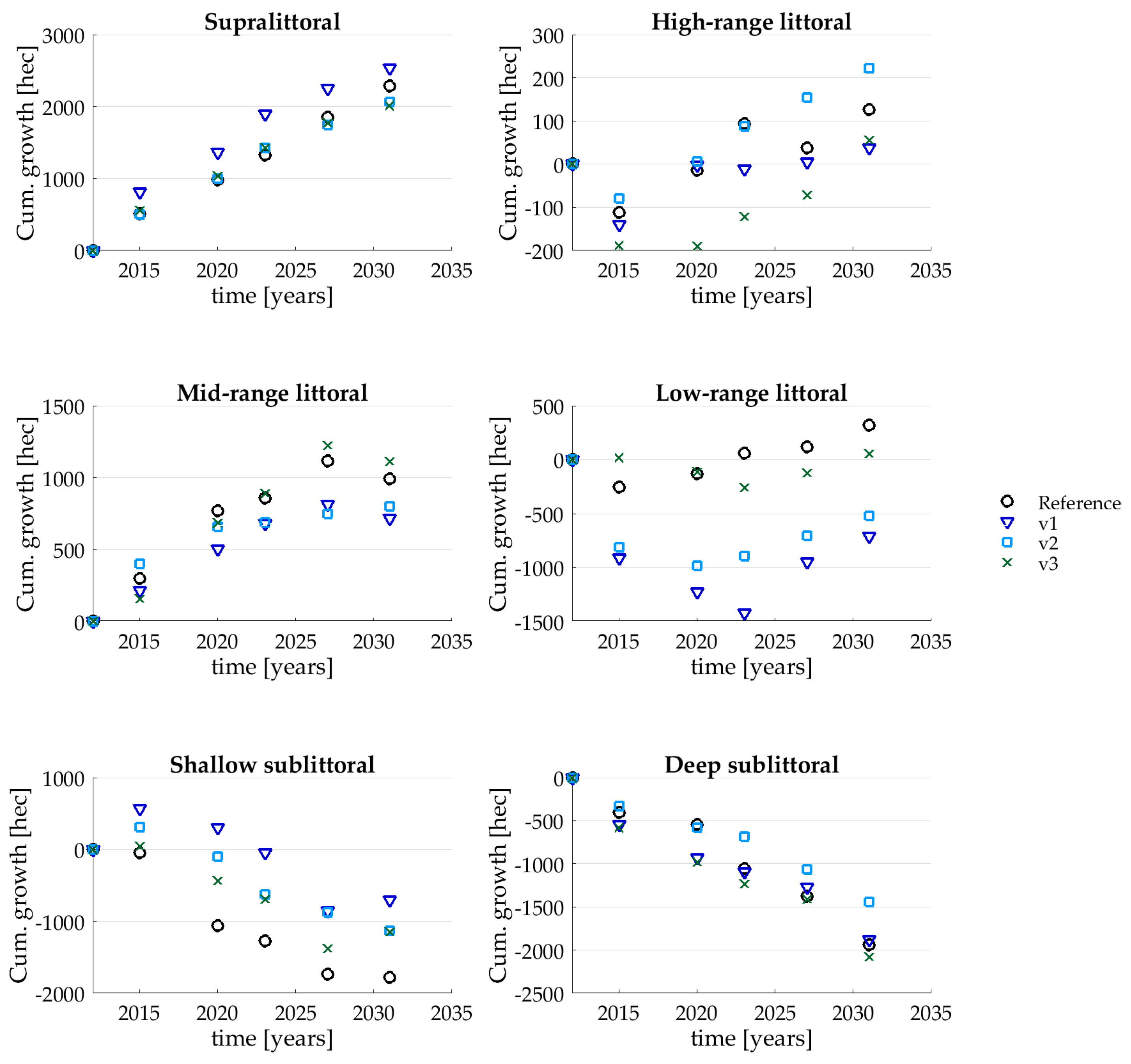
| Scenario | Reference | v1 | v2 | v3 | ||||
|---|---|---|---|---|---|---|---|---|
| Year | 2012 | 2031 | 2012 | 2031 | 2012 | 2031 | 2012 | 2031 |
| Reclaimed | 64,245 | 64,245 | 73,114 | 73,114 | 71,189 | 71,189 | 72,253 | 72,253 |
| Supralittoral | 4814 | 7096 (2282) | 4782 | 7319 (2537) | 4806 | 6873 (2067) | 4802 | 6814 (2012) |
| High-littoral | 3254 | 3381 (126) | 2943 | 2981 (38) | 3215 | 3437 (222) | 2384 | 2439 (55) |
| Mid-range littoral | 20,634 | 21,626 (991) | 19,450 | 20,165 (715) | 20,826 | 21,629 (803) | 17,546 | 18,656 (1110) |
| Low-range littoral | 22,783 | 23,105 (321) | 18,627 | 17,919 (−708) | 18,984 | 18,465 (−519) | 20,264 | 20,320 (55) |
| Shallow sublittoral | 61,341 | 59,559 (−1782) | 58,900 | 58,196 (−704) | 59,076 | 57,948 (−1128) | 60,159 | 59,009 (−1150) |
| Deep sublittoral | 175,751 | 173,813 (−1939) | 175,007 | 173,129 (−1877) | 174,728 | 173,283 (−1446) | 175,415 | 173,332 (−2082) |
© 2020 by the authors. Licensee MDPI, Basel, Switzerland. This article is an open access article distributed under the terms and conditions of the Creative Commons Attribution (CC BY) license (http://creativecommons.org/licenses/by/4.0/).
Share and Cite
Muller, J.R.M.; Chan, Y.-C.; Piersma, T.; Chen, Y.-p.; Aarninkhof, S.G.J.; Hassell, C.J.; Tao, J.-f.; Gong, Z.; Wang, Z.B.; van Maren, D.S. Building for Nature: Preserving Threatened Bird Habitat in Port Design. Water 2020, 12, 2134. https://doi.org/10.3390/w12082134
Muller JRM, Chan Y-C, Piersma T, Chen Y-p, Aarninkhof SGJ, Hassell CJ, Tao J-f, Gong Z, Wang ZB, van Maren DS. Building for Nature: Preserving Threatened Bird Habitat in Port Design. Water. 2020; 12(8):2134. https://doi.org/10.3390/w12082134
Chicago/Turabian StyleMuller, Jos R. M., Ying-Chi Chan, Theunis Piersma, Yong-ping Chen, Stefan G. J. Aarninkhof, Chris J. Hassell, Jian-feng Tao, Zheng Gong, Zheng Bing Wang, and Dirk S. van Maren. 2020. "Building for Nature: Preserving Threatened Bird Habitat in Port Design" Water 12, no. 8: 2134. https://doi.org/10.3390/w12082134
APA StyleMuller, J. R. M., Chan, Y.-C., Piersma, T., Chen, Y.-p., Aarninkhof, S. G. J., Hassell, C. J., Tao, J.-f., Gong, Z., Wang, Z. B., & van Maren, D. S. (2020). Building for Nature: Preserving Threatened Bird Habitat in Port Design. Water, 12(8), 2134. https://doi.org/10.3390/w12082134







